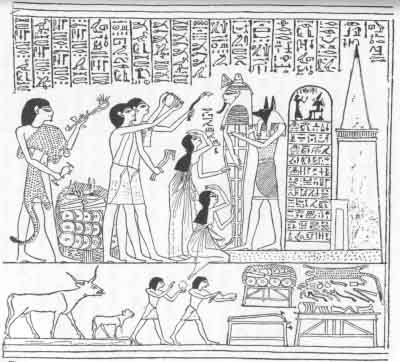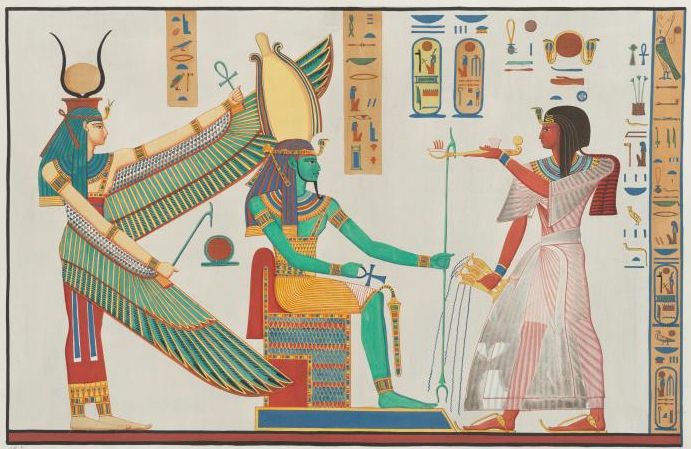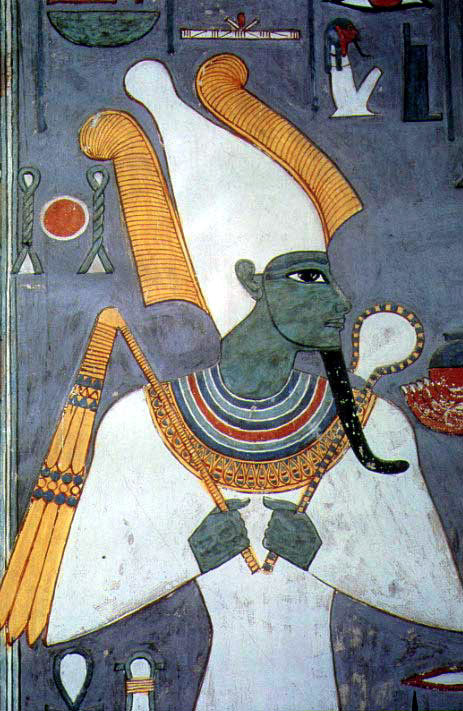Here is an excellent interpretation of “The Awakening of Osiris” from the Egyptian Book of the Dead.
Lord Osiris – Air and earth are my horizons. What lies between is what I am. O infinite form of being: beast and stone and vegetable; the way a man may stand in his garden or dance by the river while wakes of small boats rock the reeds. The cities and the people in them, gods who walk in white linen, like women under the blue stone of heaven.
I am the priest in a hidden house, guide to inner worlds. I am the idea of myself in my mother’s belly, a bright trembling star in the memory of morning, a grain of sand blown east. I am the husband of Isis: woman, and widow, and witch. To embrace her is to dream of ripening wheat. To sleep in her arms is to dream of honey. With a word she drives the snakes from the river. The boats sail far to its mouth.
Air is what I breathe. Earth is where I stand. I have given my face to Amenta. It is white with heat. The world is bright as bronze. The dead rise up to see me, breathe the air and look into my face, a yellow disk on the eastern horizon.
SOURCE: The Awakening of Osiris and the Transit of the Solar Barques: Royal Apotheosis in a Most Concise Book of Underworld and Sky – by Joshua Aaron Roberson
Among the many scenes and texts that occur for the first time in the Nineteenth Dynasty cenotaph of Seti I at Abydos is a representation of the awakening of Osiris by Horus, which appears directly beneath a vignette depicting the transit of the solar barques. The annotations to this bi-partite tableau appear in a mixture of standard, hieroglyphic Egyptian and cryptographic scripts. Similar groups of scenes and texts occur in the Twentieth Dynasty royal tombs of Ramesses VI (KV9) and Ramesses IX (KV6), the Twenty-Second Dynasty tomb of Sheshonq III at Tanis (NRT5), and the Twenty-Sixth Dynasty private tomb of Mutirdis at Thebes (TT410). In addition, significant, albeit partial parallels occur on the Twenty-Second Dynasty sarcophagus of Psusennes and a Ptolemaic sarcophagus inscribed for a certain Khaf. This study offers a summary of the scenes’ iconography together with the first synoptic edition of the relevant annotations, taking into account all currently published exemplars.
Many of the cryptographic texts are translated here for the first time, with improved or significantly expanded readings for other texts, which had been discussed in prior literature. The author also considers the meaning and context of the paired scenes in both royal and private monuments, in order to demonstrate the status of the bi-partite tableau as a unified composition. This composition is identified as a concise representative of the cosmological genre referred to usually as the Books of the Underworld and Sky.

Moe is the founder of GnosticWarrior.com. He is a father, husband, author, martial arts black belt, and an expert in Gnosticism, the occult, and esotericism.







